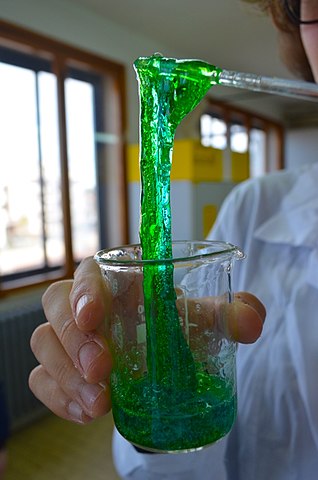
Polymers
By Monica Esopi
The intention of this lesson is to learn background about polymer materials and their applications, and to explore these materials through hands-on activities (making slime and bouncy balls). Students will be able to make their own polymers and explore their properties. These activities can be done individually, or in pairs or groups. Students will make slime to explore cross-linking, and then make bouncy balls to see the impact of a thickening agent.
QUESTION
How can simple molecules be joined together in chains or networks to make a substance with different properties?
Background
Polymers are molecules made up of repeating units (hence “poly”), called monomers. They are found in nature (hair, spiderwebs, rubber) and have been synthesized (Teflon, nylon, rubber), and have a variety of attractive properties including flexibility, elasticity, strength, heat resistance, chemical resistance, and many more. Because polymers have variation in the way they are processed and produced, these properties can be tuned in interesting and useful ways.
Silly putty is an easy and relatable example of this. One process that can be done in polymer production is cross-linking, where a chemical reaction forms bonds between separate polymer chains. In this activity, you will start with glue, and then add a cross-linker that will result in a slime material that is similar to silly putty. Glue is a polymer, and borax induces cross-linking which makes the liquid glue solution more like a solid that can be picked up and formed with your hands, though it still has some liquid-like properties (if set on a surface and left alone, it will spread into a puddle, though it can then be reformed and will continue to cling to itself like a solid).
Corn starch is another polymer that forms into granules that like to absorb water and expand when they do. This leads to some interesting properties (mixed with water it forms oobleck) and makes it a good thickening agent in sauces. Again, borax acts as a cross-linker and causes the glue to stick to itself, and this time the addition of corn starch absorbs water and acts as a “thickener”, making the material even more solid-like than the slime and enabling it to stay together in a ball. Because of its inherent flexibility and elasticity, the ball is rubbery and bounces.

Research Connection
Polymers are important in almost every research area. Organic solar cells are a popular research area, due to the relative abundance, low cost, and tunable optical properties that polymers offer compared to inorganic solar cell materials.
NGSS Standards
| Standard Number | Standard text |
| 5-PS1-3 | Make observations and measurements to identify materials based on their properties. |
| MS-PS1-2 | Analyze and interpret data on the properties of substances before and after the substances interact to determine if a chemical reaction has occurred. [ |
| HS-PS2-6 | Communicate scientific and technical information about why the molecular-level structure is important in the functioning of designed materials. |
Materials
Making Slime
- Elmer’s glue
- Water
- Borax solution (4% by weight in water)
- Cups
- Disposable pipette
- Stir sticks
- Paper towels
- Food coloring (optional)
- Plastic bags (optional, if the students want to take slime with them)
Making Bouncy Balls
- Elmer’s glue
- Water
- Borax
- Corn starch
- Cups
- Stir sticks
- Paper towels
- Food coloring (optional)
Procedure
Making Slime
- Mix glue and water in an approximate 1:1 ratio (a good amount is about a quarter cup of each). If desired, add food coloring to this solution
- Add the borax solution to the glue solution slowly, with the pipette, while stirring. What happens?
- Continue adding borax until the solution is no longer liquid and can be picked up and formed with your hands. Observe how the solution changes upon borax addition. The glue solution should clump and cling to itself when the borax is added.
Making Bouncy Balls
- Combine water, corn starch, and borax in one cup (4 tbsp water, 3 tbsp corn starch, ½ tsp borax or whatever amount is desired, in the same ratio)
- In another cup, pour 1 tbsp glue, mix with food coloring if desired
- Stir the water mixture into the glue until it forms a ball that you can roll and form in your hands. Note: it will be sticky, but you can roll it until it is no longer sticky and it should form a functional bouncy ball.
Extensions
Making Slime
Think about (can try it out) what would happen if you left the material out to dry – would it solidify or crumble? You can discuss potential applications of this type of material such as in filling molds in manufacturing, or filling cracks and holes in surfaces (cracks in roads, caulk applications).
Making Bouncy Balls
You can again discuss what might happen if the ball dries out. How is this different from a bouncy ball you would buy at a store (usually those are harder and keep their perfectly round shape, they also have a coating on them to keep them together and keep them from drying out).
Resources
This lesson plan was adapted from a workshop developed by the student organization Women in Chemical Engineering at the University of Washington.



